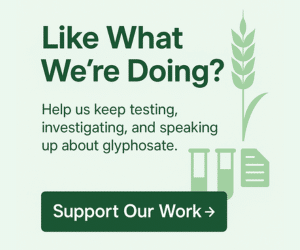A groundbreaking new study shows glyphosate causes cancer at low doses—across 14 tumor types. The evidence is in. So why are we still using it?
How many times have you heard it?
“Oh, glyphosate’s safe—it’s been used for decades.”
“There’s no solid proof it causes cancer.”
“The science is settled.”
Except… it isn’t. Not even close.
A brand-new study published in June 2025 just shattered those claims—and if you’ve got kids, care about what’s in your food, or ever walked barefoot through a local park, you’ll want to know what it found.
From the Womb to the Grave—Glyphosate Was There
This wasn’t just another lab experiment. Researchers exposed pregnant rats to glyphosate and common weedkiller brands like Roundup Bioflow and RangerPro. Then they followed the offspring—not for a few weeks, but for their entire lives.
The results were brutal.
Cancer showed up not just in one place, but across the body:
- Leukemia
- Liver tumors
- Thyroid growths
- Ovarian and testicular cancers
- Bone, skin, adrenal, and brain tumors
These weren’t freak cases. They were consistent patterns. And they happened at doses regulators still claim are safe for us.
Related article: Why Raising MRLs Threatens Public Health
Wait—Isn’t That Dose Supposed to Be Safe?
Here’s the part that really matters. This study didn’t crank the doses to unrealistic levels. It tested exactly what regulators like the EU say is okay:
- 0.5 mg/kg/day (the Acceptable Daily Intake)
- 50 mg/kg/day (the so-called No Harm level)
But guess what? Both doses caused problems.
In fact, some of the worst outcomes—like leukemia—happened at the lower dose. That’s a red flag for endocrine disruption, where small amounts can mess with the body in ways bigger doses don’t.
So, the old idea of “the dose makes the poison”? It doesn’t hold up here.
Real-World Weedkillers = Bigger Problem
You might hear defenders say, “But that’s just glyphosate—not the products we use.”
Well, this study covered that too.
It tested actual formulations—the stuff in spray bottles at the hardware store and used by councils and farmers. And guess what? They were worse.
It turns out that the other ingredients (often referred to as “inert”) actually make the poison even more potent.
So when someone says, “Glyphosate’s not that bad,” maybe they’re right.
But Roundup? RangerPro?
The full cocktail? That’s where things get deadly.
Early Deaths, Young Victims
One of the most haunting findings: 40% of leukemia deaths happened before one year of age in the rats. That’s like a teenager in human terms.
So ask yourself:
- What happens when kids are exposed in the womb?
- Or crawl on freshly sprayed school grounds?
- Or eat cereal made from grain desiccated with glyphosate?
We don’t have to wonder. We just don’t want to know.
What More Will It Take?
We’ve seen the court cases. We’ve read the labels (or tried to). We’ve watched cancer rates climb.
But somehow, this keeps getting brushed aside.
Regulators delay. Industry deflects. And the public? We’re left holding the risk.
New Zealand is currently reviewing glyphosate residue limits in food. And believe it or not, there’s talk of raising them.
Raising them.
After this study, how is that even on the table?
If Glyphosate Were a Drug, It Would Be Pulled
Let’s get real for a second.
If glyphosate were a pharmaceutical, it would’ve been pulled off the market years ago. The lawsuits alone would’ve stopped it cold.
But it’s not a drug. It’s a cash cow. A billion-dollar cornerstone of industrial agriculture. And that’s what makes it harder to quit.
But let’s be clear: this study doesn’t just suggest risk. It doesn’t “hint” or “imply.” It shows it.
Across 14 tumor types. At doses we’re told are safe. With real-world products.
What we choose to do with that truth? That’s on us.
Resources & References:
It’s easy to dismiss one study. It’s harder to ignore a growing body of evidence—especially when it stretches across years, continents, courtrooms, and cancer wards. Below is a carefully curated list of key research, expert insights, and documented history that strengthens the case against glyphosate. These aren’t fringe voices. They’re scientists, journalists, and institutions asking the questions that should have been answered long ago.
Peer-Reviewed Studies & Reports
Manservisi F et al. (2025) – Carcinogenic effects of long-term exposure from prenatal life to glyphosate and glyphosate-based herbicides in Sprague–Dawley rats.
Groundbreaking study that found 14 different tumor types across multiple organs in rats exposed to low doses of glyphosate and Roundup-like formulations.
Read study
IARC Monograph Volume 112 (2015) – Glyphosate Classification as “Probably Carcinogenic to Humans.”
Issued by the World Health Organization’s International Agency for Research on Cancer. This report was the catalyst for global lawsuits against Bayer/Monsanto.
Read IARC Monograph on Glyphosate
Portier, C.J. (2016) – Comprehensive analysis of animal carcinogenicity data for glyphosate.
Former U.S. government toxicologist reviews and affirms the cancer findings from multiple glyphosate studies. Often cited in legal challenges and risk reassessments.
View document
Mesnage R, Antoniou MN (2017) – Facts and fallacies in the debate on glyphosate toxicity.
A deep dive into regulatory inconsistencies, conflicts of interest, and underreported risks of glyphosate exposure.
Read full article
Books
Whitewash: The Story of a Weed Killer, Cancer, and the Corruption of Science
By Carey Gillam (2017)
Written by a veteran journalist, this exposé lays bare how Monsanto shaped the public narrative, manipulated regulators, and silenced critics—all while evidence mounted that Roundup was dangerous.
Whitewash [our review]
Videos
The Monsanto Papers – DW Documentary (2022)
A comprehensive documentary exploring the courtroom drama, whistleblower revelations, and scientific evidence challenging glyphosate safety.
Watch on YouTube
Poisoned Fields – Glyphosate, the underrated risk? (Full Documentary, 2015)
A sobering documentary exploring glyphosate’s widespread use, contested safety, and environmental concerns.
Watch the documentary
The science is no longer isolated. The warnings have been echoing for decades. Whether through data, lived experience, or legal fallout, the message is clear: glyphosate’s legacy is catching up with us. The only question now is—will we listen?
Image Source & Attribution
We’re grateful to the talented photographers and designers whose work enhances our content. The feature image on this page is by BVDC01.




